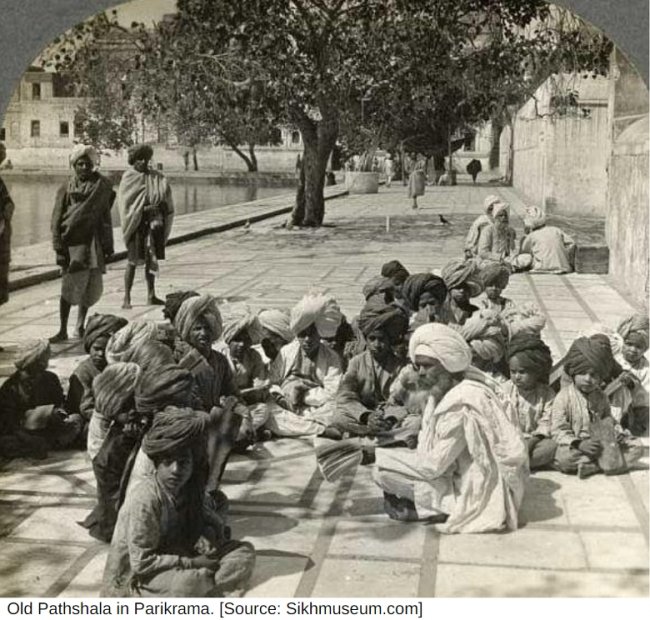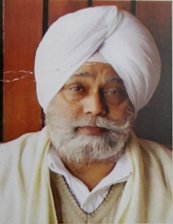The Persian word Bunga means a rest house or a dwelling. In Sikhism, the rest houses made for Pilgrims were often regarded as Bungas.
According to Rattan Singh Bhangu the bungas around Sri Darbar Sahib were erected when the work of Sarover (holy tank) was first started. Dr. Madanjit Kaur believes that originally there were only huts around Sarovar and were not called Bungas.
Some other historians believe that since invaders from Afghanistan had to cross Punjab, the region was constantly under threat. Sikhs were regularly improving their defense systems. To eliminate the Sikh threat, these invaders started to look for their weaknesses. They were suggested that the holy pond of Harimandir Sahib is the source of energy for these Sikhs, and it is said to possess some miraculous powers. Hence, they diverted their attention to the holy shrine and made regular efforts to destroy it.
Several times the Sarover was desecrated, and Harimander Sahib was damaged. Every time the Sikhs repaired it, but in 1762 Ahmed Shah Abdali attacked and blew the Sanctum with a cannon and filled the tank with dead cattle, mostly cows. After this destruction when Abdali left for Afghanistan, Sikhs assembled at Sri Darbar sahib and discussed the security of the shrine. They decided to construct a row of houses (Bungas) around the Parikarma (circumambulation) of Sarover. All the Sikh leaders, who could afford, came forward for this task. S. Jassa Singh Ahluwalia, S. Jassa Singh Ramgarhia, S. Kanahiya and Bhangi Sardars came forward and took the duty to encourage others for these Bungas. These Bungas served dual purpose: one to give accommodation to the pilgrims and second to provide security to Sri Harmandir Sahib. A manager was appointed for each Bunga and was called ‘Bungai’. Along with Bungai some soldiers were also stationed at each Bunga. History suggests that most of the Bungas came into existence in the eighteenth century.
Giani Gian Singh ji writes that the first Bunga, built in Bikrami 1663 (1606 AD), was the Akal Bunga (later Akal Takht). It was opposite Darshani Deodhi, along the west side of the Sarovar. It started as a small plinth/platform, founded by Sixth guru, Sri Guru Hargobind Sahib ji, who marked the seat of Guru Ramdas, from where he administered the construction of the Sarovar. The Bunga however was completed later with the cost of Rs. 2.73,000/-. There were 69 Bungas, completed later on all sides of the sarovar. Along the West, North, East and South side we had 28, 9, 10 and 22 Bungas respectively.
Giani Gian Singh ji also tells us that there was a single story Bunga made by Majhbi Sikhs on the east side of Sarover, costing Rs. 5000/-, in Bikrami 1634 ( 1577 AD). But on other hand S. Karam Singh Historian says that it was a 2 story structure and built in Bikrami 1839 (1782 AD).This difference in dates needs further research, as if we accept the date by Giani ji, the Bunga of Majhbi Sikhs becomes the first ever Bunga to be constructed along the shrine.
S. Karam Singh Historian writes that total number of Bungas were 74. According to him, Bungas on the West side were 28, Bungas on the Northside of Sarover were 14, Bungas on the East side were 10 and Bungas on the South side were 22.
Dr. Madan jit Kaur studied some old historical manuscripts that counted the Bungas to be 84. However, proper detail was available for 74 only. In a later article, I will try to elaborate these 74 Bungas.
Barron Charls Hughal writes during his journey in the Punjab (1884), that he visited Sri Harmandir Sahib. He says that the Sarover (Holy Tank) was surrounded with considerably good houses. Each house has windows open-able towards the temple and one can have a glance of it. Most of the houses have stairs opening in the Parikarma. All the entries to Darbar Sahib were secured with gates.
In the Territory Gazette of the East India Company (1854),it is mentioned that Amritsar city is a walled city, the streets are narrow, but the buildings are made of kiln (Pucca) bricks. The city is famous for a Holy place of Sikhs called Harimandir and its Sarover (holy Tank). The water of Sarover is crystal clear, and the priests and other Akali sardars had made their houses around the Sarover.
Giani Gian singh ji tells us that the early Bungas made around Sarover were three, and others came later. Of the famous leaders, Kanhya Sardars were the first to make their Bunga, on Western side of Sarover in Bikrami 1809 (1752 AD) which was a three story building. Two Bungas were constructed on Eastern side in Bikrami 1812 (1755 AD). One was Bunga Akhara Santokh Dass which was six (6) stories and cost Rs. 31,500/-. Second was the Bunga of S. Jassa Singh Ramgarhia, which was 4 stories and cost Rs. 2,75,000/-. Giani Gian Singh mentions Bunga Ramgarhia as a 2-Storeyed structure. Perhaps he might have counted from the Sarovar level, which is one story below the ground level. Hence, the block at the Sarovar level should ideally be considered as a basement, making the total basement count to 3 and levels above ground as 1.
Karam Singh Historian accepts that this Ramgarhia Bunga is biggest among all the bungas and it has two watch towers (minarets).
It is important to mention that it was the far sightedness of S. Jassa Singh Ramgarhia keeping the security concerns in mind. One drummer was deputed on one tower 24 hrs. to keep an eye on any incoming enemy. This drum was used to alert the Sikh soldiers stationed at the Bungas to prepare for defense.
Some people call the watchtowers as the Bunga. However, they are just a security feature added to the actual Bunga. Jassa Singh Ramgarhia also added watchtowers to Sri TaranTaran Sahib, where a Bunga was constructed later.
Most of the Bungas came into existence after 1755 AD. They provided a protective cover to the Shrine, and were also used by pilgrims as inns. Moreover, these buildings became centers for the development of Education, Music, Literature and Art. Several socio-cultural activities started revolving around these. For example, the Akal Bunga, which later became Akal Takht, is till date the supreme administrative seat of the Sikh religion. It served this purpose since the Misl days, when all decisions related to trading, religion, politics and administration were taken from here.
These Bungas are divided in the following categories.
Misl Bungas: Belonging to Sikh Misls.
Personal Bungas: Belonging to various chiefs or sardars.
Community Bungas: Bunga belonging to prominent communities.
Religious Sect Bungas: Bungas belong to various religious sects like Nirmalas, Sewa Panthies and Udasies etc.
There were also Bungas belonging to groups doing different services in the area.
Talking of the development of Socio-Cultural activities, some examples are prominent:
~Sant Nihal Singh ji of Bunga Solhanwala, was a great poet. He wrote Kavendra Parkash Granth in this Bunga.
~Bunga Ahluwalia was famous for Kirtan. Mother of S. Jassa Singh Ahluwalia was well known for her Kirtan and she performed it daily in this Bunga.
~Bhai Sant Singh, who lived in Bunga Granthian, was a great scholar and he wrote a good book on Amrit.
~S. Gurmakh Singh Granthi of Akal Bunga was also a renowned poet and he compiled Gurbilas Patshahi Chhevi.
~Bhai Budh Singh, who lived in Bunga Shaheedan was a celebrated translator and worked in the court of Maharaja Ranjit Singh. He translated many Persian manuscripts in Hindawi for Maharaja.
~S. Rattan Singh Bhangu, who was residing in Bunga Sham Singh (Bunga Singh Puria) completed his famous book PrachinPanth Parkash in 1841 AD here.
~Bhai Santokh Singh Chudamani completed his famous Granth Suraj Parkash while staying in Bunga Gianian.
~Bunga Udasi and Nirmalas were educational centers, famous for teaching Sanskrit and Gurmukhi languages.
Some bungas were famous for teaching musical instruments, Ragas, Kirtan etc.
Bunga Jalianwala was famous for the treatment of skin diseases.
V.N. Datta writes that Harimandir Sahib is surrounded with many Bungas and most of them have paintings of Kangra art. Some artists used to stay in these Bungas and did their paintings.
The parikarma of Sri Harimandir was always surrounded with rich Heritage in various forms. But all that is lost to development, in the form of widening of the Parikarma. We are only left with Akal Bunga (Akal Takht) and Bunga Ramgarhia only.
Gurdev Singh Rooprai
Delhi






